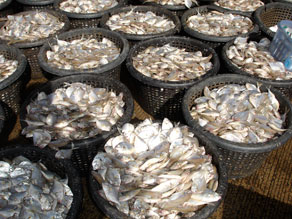



Effective fisheries management has always been a challenge, especially in complex multi-species, multi-gear fisheries. Traditional stock-based approaches have largely been ineffective, with management measures often not taking other important aspects of the fisheries into account. As many fisheries have declined over the past 30 years, the need for more effective and equitable management is increasingly evident.
The ecosystem approach offers a practical and effective means to manage fisheries more holistically. It represents a move away from fisheries management that focuses on target species, towards systems and decision-making processes that balance environmental, human and social well-being within improved governance frameworks.
Fisheries face many threats and issues and fisheries and the aquatic environment are severely degraded in many parts of the World, especially in Asia. This in turn threatens fishing communities and key stakeholders along the value chain that are dependent on fish and fisheries for their livelihoods, and on a larger scale, the economy of districts, provinces and the nation.
Fisheries management in the past has focused on fish and fishing. Many of the broader issues were not considered and, therefore, were not that successful.
EAFM aims to maximise ecosystem benefits that all lead towards increased food security and reduced poverty. The ecosystem benefits that can be achieved through EAFM include fish for food, income, employment, and livelihoods, resulting in increased food security and reduced poverty, as well as through increased foreign exchange and trade from fish and fishery products, providing that the increased foreign revenue trickle down to the poorer people. Other ecosystem benefits, such as coastal protection are also enhanced.
It is important to realise that EAFM is not really new – it builds on what is already in place in your country and fisheries. For example, You will already be doing some fishery management that will include co-management. Also importantly, EAFM recognizes that human skills are just as important as technical and scientific knowledge.
EAFM strengthens co-management with its focus on stakeholder engagement, facilitation, negotiation and conflict resolution; these are all important skills in finding solutions to the issues.
Support for an ecosystem approach to fisheries management has long been in place through a range of global declarations and policy instruments. Recognition also exists at the national and regional levels that it offers the most practical and effective way to manage complex fisheries. However, progress in developing ecosystem-based management plans has been slow, mainly due to a lack of experience in implementing this integrated and holistic approach.
Use of the ecosystem approach to fisheries management has been endorsed by:
EAFM encourages good planning, and implementing actions linked logically to these plans and higher level policies/legislation. It emphasises that having an EAFM plan will help link the high-level policy objectives, often derived from International Conventions, Treaties, and similar instruments, as well as national legislation and policies that already exist in most countries with actual management actions on the ground that will implement those policies.
Legislation and policies say what needs to be achieved. Plans (linked to rules and regulations) say how they will be achieved.
IN SUMMARY
EAFM is a framework to help you bring different management strategies/approaches together in a clear, logical and structured approach with relevance to fisheries (e.g. co-management, coastal zone management, MPAs etc)
EAFM provides a better planning and management framework and focuses on the REAL issues and what is causing them across the ecological, social and economic dimensions of sustainable development
EAFM will help to reduce conflict, resulting in fewer protests and greater support from your people
EAFM will improve the ability of your staff to manage natural resources
EAFM can help you get more funding by
a) having well-designed plans that will influence your national budget allocation and donor funding support;
b) sharing finances and resources with other partners;
c) providing support for reallocation of funds for more effective/efficient use
Other selling points (depending on the audience) are:
EAFM helps stakeholders increase their sense of stewardship of the resources that they are dependent on and they are more likely to comply with management rules and regulations
EAFM strengthens co-management and can help coordinate staff and resources of different agencies
EAFM will result in better management of the resources in your country that will increase demand for your fish and secure a larger market share
EAFM is adaptable and can be applied to other systems such as inland fisheries
EAFM helps to improve your image as a leader and establish a legacy for introducing a fully integrated approach to fishery governance